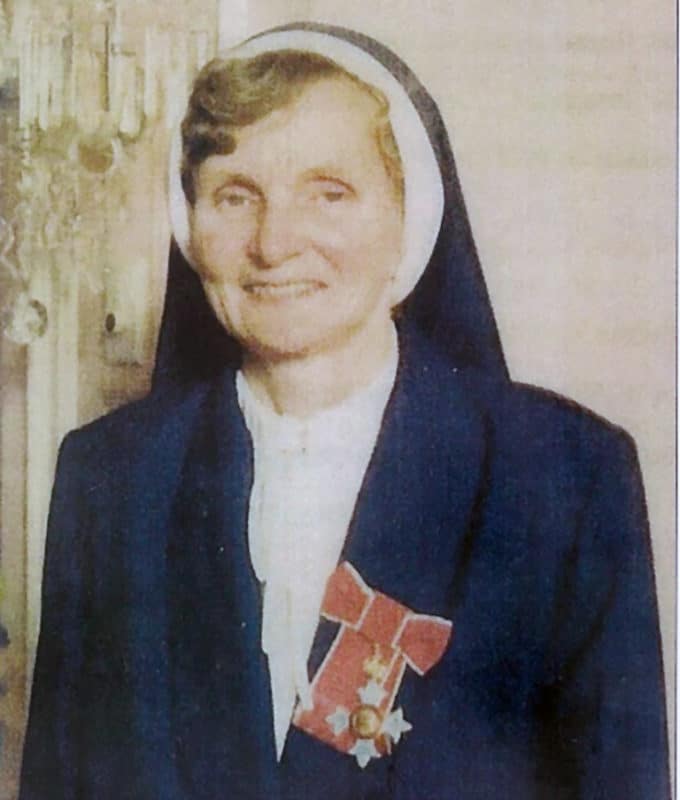The principal pioneer of the modern hospice movement in Auckland, Sr Margaret Mary Timms, RSM, CBE, was farewelled in Auckland this month.
Many tributes were paid at a vigil celebration on July 14 and at requiem Mass on July 15 in St Mary’s Convent chapel in Ponsonby. Sr Margaret died on July 11, aged 89.
At the vigil, Harbour Hospice chief executive Jan Nichols said anyone associated with the early days of the modern hospice movement in Auckland would likely refer to Sr Margaret as “the key leader and trailblazer”.
“This was an honour that did not sit easily with this humble woman, as she saw herself as bringing to bear the long-held legacy of the Auckland-based Sisters of Mercy, who opened the first hospice for the dying at the Mater Hospital in 1953,” Ms Nichols said.
But, at the time, Sr Rita Vessey, RSM, noted in her eulogy at the requiem, “such was the public discomfort and even fear of the word ‘hospice’ that the name was changed to the Mary Agnes Wards for the Aged and the Dying”.
A former Tutor-in-Charge of the Mater School of Nursing in Auckland (when she was known by her religious name of Sr Mary James), Sr Margaret took the opportunity in the 1970s to observe first hand the developments in care for the dying taking place at three UK hospitals that were leaders in this changing field.
She went on to become Sister-in-Charge of St Joseph’s Unit for Continuing Care, on the top floor of the closed Mater Hospital. The unit, specifically appointed for care of the dying, opened in 1979. This was one of three modern hospice units to open in New Zealand that year, the others being Mary Potter Hospice in Wellington, established by the Little Company of Mary, and Te Omanga House in Lower Hutt.
Ms Nichols described the early days of the St Joseph’s Unit as a “wonderful collaboration” between the Auckland Area Health Board, the Cancer Society and the Sisters of Mercy.
She said Sr Margaret became involved with local health care professional training, wrote articles and became involved with the national hospice organisation.
“There are many individuals and families who remember Sr Margaret with intense gratitude and affection. Her work was all-encompassing and she was often present at night and weekends. She led a team of dedicated nurses [and] for many years worked very closely with three visiting doctors.
“Not only were people cared for in life, they were cared for in death, with Sr Margaret and her fellow sisters attending each funeral.”
Ms Nichols said that Sr Margaret, who retired from St Joseph’s in 1992, was always supportive and encouraging, could easily relate to people and put them at ease and had a “very dry wit”.
Sr Rita said that Sr Margaret knew that all people are in need of healing in some sense “and that acts of kindness bring new life, not only to the person helped but also to the one giving”.
“This is the message she shared with her staff and it informed their approach in caring for their patients.
“She encouraged those who came to the hospice to make it a place to live as fully and as comfortably as possible, in order to die well.”
Nothing was considered too out of the ordinary if it might bring comfort and perhaps closure for a patient and family.
Sr Rita gave examples from Sr Margaret’s time at St Joseph’s of a man allowed to bring his wake forward to be with family and friends before he died, a bride-to-be who went through with the ceremony on the ward, and a man taken down from the ward to see his much-loved pony a few hours before he died.
“There are endless examples of such moments – and all are precious,” Sr Rita said.
“Margaret was first and foremost a faithful Sister of Mercy, whose gift of faith was a living one,” Sr Rita added.
“Her own spiritual journey was never just enough for her, and she earnestly engaged in reading and prayer to nourish that faith which she had generously shared with others throughout her long ministry of nursing.”
Sr Margaret’s pioneering work was acknowledged with her being made a Commander of the British Empire (CBE) in 1989.
At the requiem, Msgr Bernard Kiely described Sr Margaret as “a shining star”.
“With the days that we are living in and a certain referendum that is coming up, it is probably appropriate for us to acknowledge Margaret and her stand in the whole end-of-life journey,” Msgr Kiely said.
He added a quote from Dame Cicely Saunders, the modern founder of the hospice movement in the 1960s: “You matter because you are you, and you matter to the last day of your life. We will do everything we can, not only to help you die peacefully, but also to live until you die.”

Reader Interactions